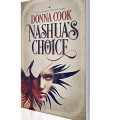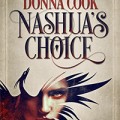When I was getting ready to release my novella Nashua’s Choice, I pondered how to let readers know what kind of story to expect. I mean, aside from magical, enchanting, and awesome. 😉 Seriously, I’m specifically talking about length.
Originally, Nashua’s Choice was going to be a short story. But, as will not surprise readers of Gift of the Phoenix, I don’t think short. I like layers. I like a fully dimensional world. I like fully dimensional characters. I like lots of things happening with the plot. It’s what makes a story fun and worth telling (and worth reading). In short (no pun intended) it’s what makes a story rich. I had more to say about Nashua than originally planned, and hallelujah for that. I absolutely love her character and I love that story.
I told Nashua’s story the way it needed to be told, but it’s too long to be a short story and too short to be a novel.
Back in the day, readers were well versed with the terms novella and novelette. Not so much any more. Thanks to the economic limitations of traditional publishing, readers have had several decades of primarily two choices: novels and short stories. You will see the occasional novella. When’s the last time you heard of a novelette?
With the advent of the eBook age, anything goes. Writers are now telling their stories in the way that best suits their story, let the final word count fall where it may. This is good for storytelling, but potentially confusing for readers. Readers need to know what to expect when they start reading a story. Are they getting a full-length novel, complete with a few fully-developed sub-plots, or are they getting a novella where the focus is on one main plot? Correctly communicating what to expect is an important job of the writer, because false expectations can lead to reader disappointment in an otherwise lovely story.
It doesn’t help that there’s no gold standard for classifying stories and that Indie writers vary widely in what they’re calling a novel or a novella. So, what to do?
Consider this standard set forth by the Science Fiction Writers of America:
Short fiction: up to 7,500 words
Novelette: 7,500 to 17,500 words
Novella: 17,500 – 40,000
Novel: 40,000 words and up
Readers often want to know, “How many pages is that?” The frustrating answer is, “It depends.” Formatting has a direct impact on page count. Pick up Les Miserables and Inkheart and you’ll see what I mean. There are far more words per page in the former than in the latter. Even within a single book, the word count per page will vary. A page with a lot of dialogue (and therefore, more white space) will have fewer words per page than one with a lot of narration. The first page of a chapter will have a lower word count because the chapter heading is taking up room. The last page of a chapter may have a very low word count if the text only takes up a quarter of the page.
Even knowing this, readers still ask, “Well, ABOUT how many pages is 100,000 words?” I get that. So, understanding that any page count method is an estimation, I’m going to help you out.
Based on the formatting for Gift of the Phoenix, the SFWA guidelines translate into the following page counts:
Short fiction: up to 7,500 words or up to 22 pages
Novelette: 7,500 to 17,500 words or 22-53 pages
Novella: 17,500 – 40,000 or 53-121 pages
Novel: 40,000 words and up or 121 pages and up (Gift of the Phoenix is 568 pages)
Now, I gotta say, 40,000 words for a novel seems awfully slim to me. I would think something more along the lines of 70,000 is a better length for a short novel. But this is coming from someone who wrote a 197,000 word novel.
I’m in good company though. The fourth and seventh Harry Potter books both have a word count similar to Gift of the Phoenix. Plenty of books trump that. Harry Potter and the Order of the Phoenix clocked in at 257,000 words. George R. R. Martin’s A Storm of Swords is a whopping 400,000 words. This is to demonstrate that long does not equal boring or poorly written.
Short is okay, too. Harry Potter and the Sorcerer’s Stone was a mere 77,000 words. Stephen King’s Carrie was only 60,000 words.
Of course, publishers like an author’s debut novel to be on the short side. That gives readers a chance to try out the author without too much commitment. Once an author is established, longer tomes are more acceptable (i.e. less of a financial risk to the publisher).
The changing face of today’s publishing world means rules are broken all the time. As a writer, I think that’s a good thing. Once again, storytellers have the freedom to write the story that needs to be told. Rather than worrying about the economic feasibility of word counts, we get to focus on things like plot, character development, atmosphere, and satisfying endings. We get to focus on the reader.
So, dear reader, if you’re so inclined I invite you to enjoy my story, Nashua’s Choice. A solid novella if ever there was one.





